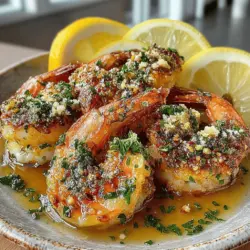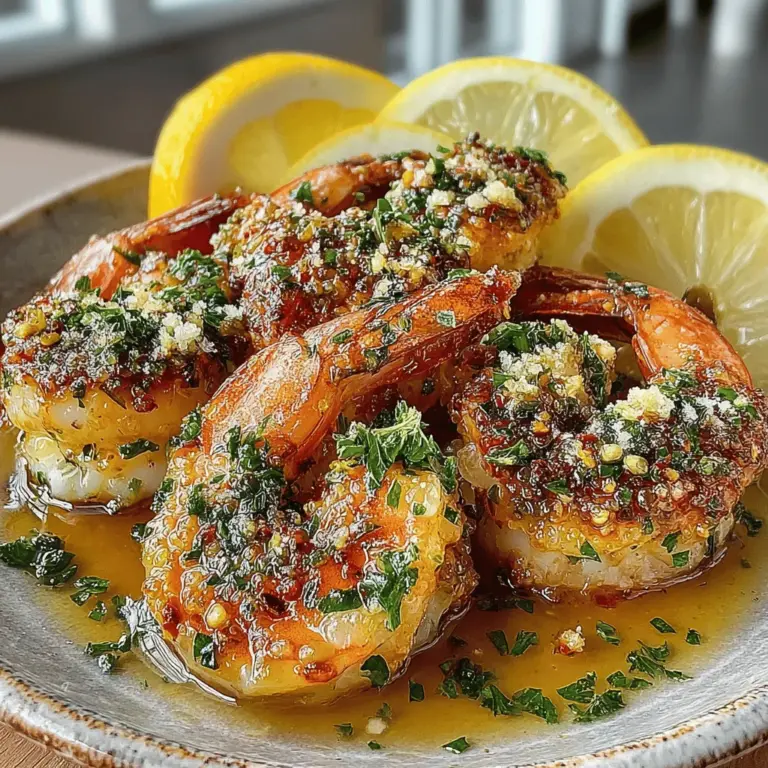Introduction
Zesty Lemon Glaze Shrimp is a delightful dish that perfectly marries the vibrant flavors of citrus with the succulent taste of shrimp, making it an ideal choice for both casual dinners and festive gatherings. This recipe not only offers an explosion of freshness on your palate but also provides a healthy, protein-packed meal that is quick and easy to prepare. The zesty notes of lemon paired with the natural sweetness of shrimp create a dish that is as pleasing to the eyes as it is to the taste buds.
Shrimp is a versatile seafood option loved worldwide, and when combined with the bright acidity of fresh lemon juice, it becomes an irresistible treat. The appeal of this dish lies not just in its flavor but also in its health benefits. Shrimp is low in calories, high in protein, and rich in essential nutrients such as omega-3 fatty acids, making it a great choice for health-conscious eaters. Additionally, the use of fresh lemon juice not only enhances the overall flavor profile but also adds a wealth of vitamin C, which is known for its immune-boosting properties.
Understanding the Ingredients
To create the perfect Zesty Lemon Glaze Shrimp, it’s essential to understand the role of each ingredient in contributing to the dish’s overall flavor and health benefits.
Shrimp: A Healthy Protein Source
Shrimp is a lean protein that is low in fat and calories while being packed with nutrients. It is a great source of selenium, which supports heart health and immune function, and vitamin B12, which is vital for energy production and brain health. When selecting shrimp for this recipe, opt for fresh or frozen shrimp that is sustainably sourced for the best taste and quality.
Fresh Lemon Juice and Zest
The star of the dish is undoubtedly the fresh lemon juice and zest. Lemon juice adds a bright acidity that cuts through the richness of the shrimp, while the zest provides an aromatic quality that enhances the overall flavor. Using fresh lemons rather than bottled juice ensures that you get the best flavor and nutritional benefits, as fresh citrus is full of antioxidants and is known to promote hydration and skin health.
Honey: Balancing Acidity and Sweetness
In this recipe, honey plays a vital role by balancing the acidity of the lemon juice. Its natural sweetness complements the shrimp beautifully, creating a well-rounded glaze that enhances the dish without overpowering it. Honey is also rich in antioxidants and has soothing properties, making it a healthier alternative to refined sugars.
Olive Oil: A Healthy Fat
Olive oil is another key ingredient that contributes to the richness of the glaze. Known for its heart-healthy monounsaturated fats, olive oil enhances the flavor of the shrimp while providing a silky texture to the marinade. It also aids in the absorption of fat-soluble vitamins, making it a nutritious choice for cooking.
Garlic and Red Pepper Flakes
Garlic adds a robust flavor that elevates the dish, giving it a savory depth that complements the sweetness of the shrimp and the acidity of the lemon. Freshly minced garlic is preferred for its strong aroma and flavor. Meanwhile, red pepper flakes introduce a hint of heat, balancing out the sweetness and acidity, and providing a delightful kick that enhances the overall flavor profile.
Garnishing with Parsley and Serving with Lemon Wedges
To finish off the dish, fresh parsley is used as a garnish, adding a pop of color and a herby freshness that brightens the presentation. Serving the shrimp with additional lemon wedges not only looks appealing but also allows diners to add extra acidity to taste, enhancing the dish even further.
The Marinade: A Flavorful Foundation
The marinade is the foundation of the Zesty Lemon Glaze Shrimp, infusing the shrimp with layers of flavor. The combination of fresh lemon juice, zest, honey, olive oil, minced garlic, and red pepper flakes creates a harmonious blend that penetrates the shrimp, making every bite a burst of flavor.
Importance of Marinating Shrimp
Marinating shrimp is crucial as it allows the flavors to meld and penetrate the meat, which enhances both the taste and texture of the shrimp. The acidity of the lemon juice helps to tenderize the shrimp, ensuring they remain juicy and succulent when cooked. Ideally, shrimp should be marinated for at least 15 minutes, but for an even deeper flavor, a longer marinating time of up to 30 minutes is recommended.
Suggested Variations or Substitutions for the Marinade Ingredients
While the classic marinade works beautifully, feel free to get creative with variations or substitutions. For instance, if you prefer a sweeter glaze, consider adding a bit of maple syrup or agave nectar in place of honey. You can also experiment with different herbs, such as thyme or basil, for a unique twist. For those who enjoy a more pronounced heat, increasing the amount of red pepper flakes or adding a dash of hot sauce can elevate the spice level to your liking.
Step-by-Step Cooking Instructions
Preparing the Marinade
The first step in creating your Zesty Lemon Glaze Shrimp is to prepare the marinade. Start by gathering all your ingredients: fresh lemon juice, lemon zest, honey, olive oil, minced garlic, and red pepper flakes. In a medium-sized bowl, combine the lemon juice and zest for a bright and aromatic base.
Next, add the honey, allowing it to dissolve into the acidic lemon juice. Follow this with a drizzle of olive oil, which will help emulsify the marinade and coat the shrimp evenly. Finally, stir in the minced garlic and red pepper flakes, mixing thoroughly until all ingredients are well combined.
Marinating the Shrimp
Once your marinade is ready, it’s time to marinate the shrimp. Place the cleaned and deveined shrimp into a resealable plastic bag or a shallow dish. Pour the marinade over the shrimp, ensuring they are fully coated. Seal the bag or cover the dish with plastic wrap, and place it in the refrigerator.
For optimal flavor, allow the shrimp to marinate for at least 15 minutes. However, if time permits, letting them sit for 30 minutes can result in even better flavor absorption. Remember to avoid marinating for too long, as the acid in the lemon juice can start to “cook” the shrimp, altering their texture.
Best Practices for Marinating Time and Methods
When marinating shrimp, it’s essential to keep a few best practices in mind. Always marinate in the refrigerator to prevent any bacterial growth, and never reuse marinade that has come into contact with raw shrimp without first boiling it to kill any pathogens. If you’re pressed for time, even a quick 10-minute marinade can add a layer of flavor, but for the best results, aim for the recommended marinating times for maximum taste enhancement.
By following these initial steps, you will set a solid foundation for creating a flavorful and healthy dish that is sure to impress. The combination of zesty lemon and succulent shrimp makes for a delicious meal that is both satisfying and nourishing.
{{image_2}}
Preheating Cooking Surfaces
Before diving into the cooking of your Zesty Lemon Glaze Shrimp, it’s crucial to preheat your cooking surfaces properly. Whether you choose to grill or use a skillet, preheating helps to ensure that the shrimp cooks evenly and achieves that perfect sear. For grilling, preheat your grill to medium-high heat, ideally around 400°F (200°C). If you opt for a skillet, heat it over medium-high heat for a few minutes before adding oil. This step is essential to prevent the shrimp from sticking and to lock in flavor.
Differences Between Grilling and Skillet Cooking
When preparing Zesty Lemon Glaze Shrimp, the choice between grilling and skillet cooking can significantly affect the dish’s texture and flavor. Grilling imparts a smoky char and enhances the shrimp’s natural sweetness, making it an excellent option for outdoor cooking. On the other hand, cooking in a skillet allows for better control over the heat and the ability to add additional flavors directly into the pan.
Both methods have their perks; grilling offers a vibrant outdoor flavor, while skillet cooking can be more convenient for those who prefer cooking indoors. Whichever method you choose, ensure that your cooking surface is adequately preheated to achieve the best results.
Tips for Achieving the Perfect Cooking Temperature
Achieving the perfect cooking temperature is vital for succulent shrimp. For grilling, aim for a temperature between 350°F and 450°F. For skillet cooking, medium-high heat should suffice. To test if your skillet is hot enough, sprinkle a few drops of water onto the surface; if they dance and evaporate quickly, you’re ready to cook.
Using a digital thermometer can also be beneficial; shrimp are perfectly cooked when they reach an internal temperature of 120°F (49°C). This ensures that they are juicy and tender, rather than rubbery or dry.
Cooking the Shrimp
Once your cooking surface is preheated, it’s time to cook the shrimp. Place the marinated shrimp directly onto the grill or in the skillet. Make sure not to overcrowd the shrimp, which can lead to steaming instead of searing. Cooking in batches is recommended if you have a large quantity.
Explanation of Cooking Times and Visual Cues for Doneness
Cooking times will vary based on the size of the shrimp and the cooking method. Generally, shrimp will take about 2-3 minutes per side to cook. Watch for visual cues: the shrimp should turn from translucent to opaque, and their flesh will curl slightly. Ideal shrimp should be firm and juicy, not tough or shriveled.
Importance of Avoiding Overcooking
Overcooking shrimp is a common mistake that can ruin the dish. Shrimp that is cooked too long becomes rubbery and dry. To avoid this, remove the shrimp from the heat as soon as they are opaque and firm to the touch. If you’re unsure, it’s always better to err on the side of caution and check for doneness early.
Glazing the Shrimp
After cooking the shrimp, the final step is to glaze them with your zesty lemon mixture. Pour the glaze over the shrimp in the pan (or brush it over the shrimp on the grill) and allow it to simmer for about 1-2 minutes. This step enhances the shrimp’s flavor profile and gives it a shiny, appetizing appearance. The combination of lemon juice, honey, and garlic creates a deliciously sticky glaze that clings to the shrimp, elevating both flavor and presentation.
Serving Suggestions
Once your Zesty Lemon Glaze Shrimp is cooked and glazed to perfection, it’s time to serve. Here are some ideas to enhance your dining experience:
– Side Dishes: Pair your shrimp with light and refreshing sides. A simple mixed greens salad dressed with olive oil and lemon complements the shrimp beautifully. Alternatively, consider serving with seasoned rice or quinoa, which can soak up the delicious glaze.
– Presentation Tips: For an appealing presentation, arrange the shrimp on a large serving platter or individual plates. Garnish with fresh herbs like parsley or cilantro and lemon wedges for a pop of color. A sprinkle of sesame seeds can also add an elegant touch.
– Beverage Pairings: To elevate the meal experience, consider pairing the shrimp with a crisp white wine, such as Sauvignon Blanc or Pinot Grigio. For non-alcoholic options, a sparkling lemon or lime soda can enhance the zesty flavors of the dish.
Health Benefits of Zesty Lemon Glaze Shrimp
Zesty Lemon Glaze Shrimp not only delights the palate but also brings a wealth of health benefits.
– Nutritional Analysis of Shrimp: Shrimp are a low-calorie protein source, rich in essential nutrients such as selenium, vitamin B12, and iodine. A serving of shrimp contains about 24 grams of protein and only 2 grams of fat, making it an excellent choice for a healthy diet.
– Benefits of Lemon Juice and Honey: The addition of lemon juice is not only for flavor; it also provides vitamin C and antioxidants, which support the immune system and skin health. Honey, while adding sweetness, has natural antibacterial properties and can help soothe the digestive system. Together, they create a glaze that enhances the dish’s health benefits.
– Incorporating Shrimp into a Balanced Diet: Shrimp can be easily integrated into various diets, including low-carb and Mediterranean diets. Enjoying shrimp once or twice a week can diversify your protein sources and provide essential nutrients.
Conclusion
In summary, the Zesty Lemon Glaze Shrimp recipe is a simple yet flavorful dish that can brighten up any meal. With its ease of preparation and vibrant taste, it offers a delightful option for both casual dinners and special occasions.
This dish not only showcases the versatility of shrimp but also emphasizes the importance of fresh ingredients like lemon and honey in cooking. Whether you’re grilling or sautéing, the Zesty Lemon Glaze Shrimp is sure to impress and satisfy.
We encourage you to try this recipe for a fresh, healthy meal that’s bursting with flavor. Its adaptability makes it perfect for any occasion, allowing you to explore various sides and pairings. Enjoy the culinary journey that shrimp can offer!


